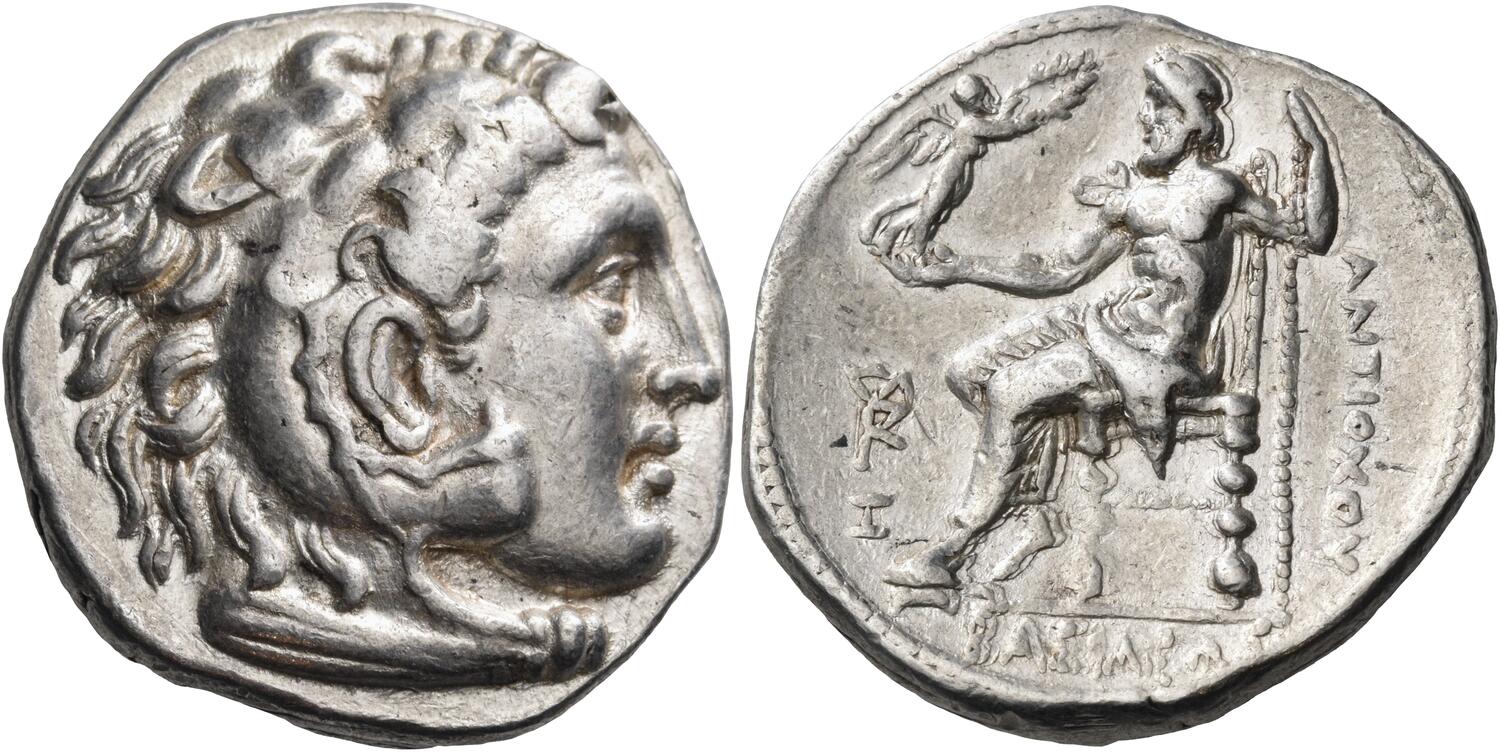Sardis (Antiochus I), silver, tetradrachms (Heracles/seated Zeus) (280-261 BCE)
From SILVER
280 BCE - 261 BCE Silver 757 kg
Description
| ObverseInscription or printing placed on the obverse.: | Beardless head of Heracles right wearing lion skin headdress |
| ReverseInscription or printing placed on the reverse.: | ANTIOXOY BAΣΙΛΕΩΣ (Greek).Zeus seated on high-backed throne left, holding Nike on outstretched right hand and sceptre in left |
Mint and issuing power
| MintIdentifies the place of manufacture or issue of a numismatic object.: | Sardis | Ancient regionAncient region.: | Lydia | Modern countryModern country: Turkey | AuthorityIdentifies the issuing power. The authority can be "pretended" when the name or the portrait of X is on the coin but he/she was not the issuing power. It can also be "uncertain" when there is no mention of X on the coin but he/she was the issuing power according to the historical sources: | Antiochus I Soter (Seleucid king, 281-261 BC), Seleucid Dynasty (312-63 BC), Alexander III the Great (Argead king, 336-323 BC) |
Chronology
| FromIdentifies the initial date in a range assigned in a numismatic context. | 280 BCE | toIdentifies the final date in a range assigned in a numismatic context.. | 261 BCE | PeriodTime period of the numismatic object.: Hellenistic 323-30 BC |
Physical description
| MetalThe physical material (usually metal) from which an object is made.: | Silver |
Median weightMedian of the weights of numismatic objects (in grams). in grams | 17.05 | DenominationTerm indicating the value of a numismatic object. Examples: tetradrachm, chalkous, denarius.: | tetradrachm |
StandardStandard.: | Attic |
Image

Sardis_Antiochus_I_zeus.jpg [1]
References
| Die study referencePublication of the study: | SC I1SC I, n° 321.1-2 | ||
| Coin series referenceReference to coin series study: | WSM2WSM, n° 1360, SC I1SC I, n° 321.1-2 | ||
| Coin series web referenceCoin series web references: | |||
Obverse dies distribution
| FrequencyFrequency of specimen in distribution. ᵖ | Number of obversesNumber of obverse dies. ᵖ (o) | % (o) | Number of coinsNumber of coins. (n) | % (n) | Die nameName(s) of the die(s). |
| 3 | 1 | 50 | 3 | 30 | 8 |
| 7 | 1 | 50 | 7 | 70 | 7 |
| Total | 2 of 2 | 100 | 10 of 10 | 100 |
Reverse dies distribution
no distribution is available
Quantification
| Number of obversesNumber of obverse dies. ᵖ (o) | 2 | Number of singletons (o1)The number of singleton coins. ᵖ | 0 |
| Number of reverse diesNumber of reverse dies. (r) | 4 | Number of coinsNumber of coins. (n) | 10 |
| Coins per obverse dieNumber of coins per obverse die. (n/o) | 5 | Coins per reverse dieNumber of coins per reverse die. (n/r) | 2.5 |
| Reverse per obverse ratioRatio of obverse dies divided by reverse dies. (r/o) | 2 | Percentage of singletons (o1)number of coins (n) divided by the number of singletons (o1) ᵖ | 0 % |
| Original number of dies (O) (Carter 1983 formula)The estimation of the number of coins according to Carter 1983 ᵖ | 2.22 | Coins struck if 20,000 as average productivity per dieCoins made if the average productivity for obverses (according to Carter) is 20,000. ᵖ | 44,400 |
| Original number of dies (O) (Esty 2011 formula)The estimation of the number of coins according to the singleton formula in Esty 2011 ᵖ (O) | 2.5 | Survival rate if 20,000 as average productivity per dieSurvival rate if average productivity is 20,000. ᵖ | 0.00023 |
| Coverage (o = % of O) (Esty 1984 formula)Esty 1984 - coverage (% of O) ᵖ (o = % of O) | 100% | Die productivity if survival rate 1/2,000Average productivity if survival rate is 1/2,000. ᵖ | 9,009.01 |
| Weight of silver (in kg) if 20,000 coins per die (O = Carter formula)Carter 1983 * Median weight * 20000 (*10 if gold or electrum) ᵖ | 757 kg <br /> 757 kg | Die productivity if survival rate 1/5,000Average productivity if survival rate is 1/5,000. ᵖ | 22,522.52 |
Remarks
Most likely one single workstation Likely military
References
- a b Houghton, Arthur - Lorber, Catharine (2002), Seleucid coins : a comprehensive catalogue. Part 1, Seleucus I through Antiochus III, New York - Lancaster - London, 2 v. (xxxviii, 488 p. + 300 p.), 101 pl.
- ^ Newell, Edward T. (1941), The coinage of the western Seleucid mints from Seleucus I to Antiochus III, Numismatic Studies 4, New York, 450 p., LXIV pl.